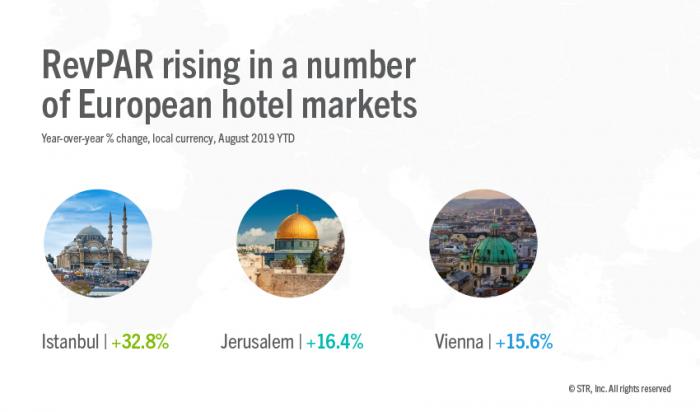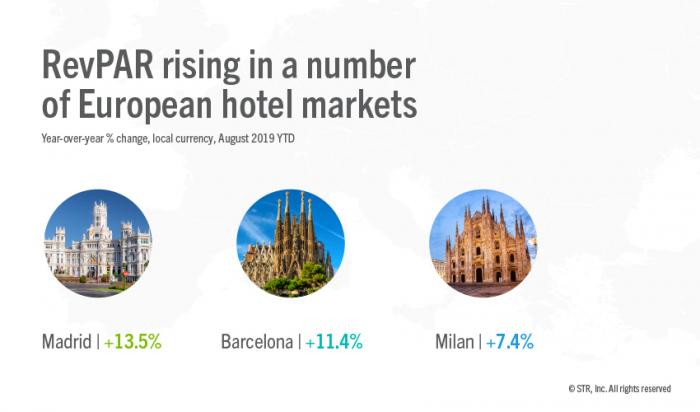There are still several months before we put 2019 in the books, but in the meantime, we’re highlighting six of Europe’s hotel markets that experienced performance growth during the first eight months of the year. We’ll pay close attention to these markets to see if their successful 2019 thus far extends through the end of the year.
6 of Europe’s successful hotel markets in 2019

1 - Istanbul
Istanbul reported significant year-over-year performance growth in the opening eight months of 2019 as RevPAR increased 32.8%. This significant lift is a sign of the market’s recovery, following a difficult period that began with a spate of terror attacks in Turkey in 2015 and a travel ban implemented due to political tensions with Russia.
However, demand rose 16.2% in 2018, and this momentum continued into 2019, with the January to August period producing a 7.0% increase. With supply also rising in 2019, albeit at a slower rate than demand, there’s an indication that investor confidence is also returning.
This trend is reflected by Istanbul’s 3.8% occupancy growth in the first eight months of the year, and the devaluation of the Turkish Lira has led to notable ADR growth, rising 28.0% over the same period. Growth against the U.S. Dollar has been muted, which reinforces Istanbul’s appeal for overseas travellers. RevPAR rose 52.6% in Q2 2019, the typical high season for leisure visitors, another tick in the returning visitor confidence box.
2 - Jerusalem
Israel’s capital produced 16.4% RevPAR growth in the opening eigth months of 2019, predominantly driven by ADR uplift of 12.7% as occupancy increased 3.3% over the same period. Jerusalem performance is consistent with market trends across the country, as Eilat (+15.2%) also reported growth in light of an increase in overnight arrivals in Israel. Following growth of 14.1% in 2018, arrivals are projected to increase by an additional 4.3% in 2019 (Source: Tourism Economics).
3 - Vienna
Austria’s capital has experienced a popularity increase in recent years, welcoming 7.5 million global visitors in 2018, a 6.0% increase on the previous year (Source: Vienna Tourism Board). Much of this can be attributed to a packed events calendar, with the Vienna Convention Bureau estimating that 12% of all overnight stays in 2018 can be attributed to congresses, meeting and incentives.
The trend for demand growth has continued, and Vienna recorded an occupancy increase of 3.5% as of August year to date. The market produced ADR growth of 11.7% over the same period, a result of double-digit increases in all market classes, leading to a RevPAR lift of 15.6%.
Forecast Q4 2019: Following a great start to the year, RevPAR is expected to fall 15.4% in Q4 as a result of comparison with a strong Q4 2018, when Vienna hosted the EU Presidency.

4 - Madrid
The Spanish capital has led RevPAR growth in the Iberian market, as a strong and balanced business mix of corporate and leisure tourism drove a 13.5% lift in the metric. Occupancy rose 2.5% in the opening eight months of 2019, but ADR growth has been the headline—up 10.7% for the same period.
June was a standout month in Madrid, as a series of events drove a 43.5% increase in ADR. The market hosted the Champions League Final, MADO 2019 and the 20th Annual European Congress of Rheumatology (EULAR), among others. As a result, the market achieved strong demand growth (+3.7%) for the January to August period and benefitted from muted supply growth of 1.2%.
Forecast Q4 2019: Following eight months of stellar performance, Madrid is expected to produce a 2.0% RevPAR decrease for the quarter. This is a result of a weaker events calendar in the latter part of the year with smaller annual events taking place.
5 - Barcelona
Following Madrid’s example, Barcelona reported an 11.4% RevPAR increase during the January-August period.
The social and political unrest caused by October 2017’s referendum caused 14 months of consecutive occupancy declines, yet Barcelona recorded a 4.5% year-over-year increase in the opening eight months of 2019. This has allowed hoteliers to once again increase rates, which are up 6.6% for the same period.
Key events have driven market performance in the first eight months of the year, including Infarma, MWC, EAU, AEDV, SILACO-GEER and EAMHID Congresses.
Another interesting driver of performance is the current dynamic between supply and demand. A moratorium on new hotels is limiting supply (+0.9%), while demand increased 5.5% for the first eight months of 2019
Forecast Q4 2019: STR analysts expect growth to continue into Q4 as Barcelona recovers from the referendum’s impact on the same period last year. RevPAR for Q4 2019 is projected to rise 4.2%.
6 - Milan
Milan makes it onto our list courtesy of an impressive July, in which hotels achived the highest absolute RevPAR level (EUR109.54) for any July in STR’s Milan database. Double-digit RevPAR increases during 4-17 July were key drivers of this growth.
While the Laura Pausini and Biagio Antonacci concerts took place at the San Siro Stadium (4-5 July), increases in tourism to the city occurred as several art museums and exhibitions opened during the summer season.
The year has been positive for Milan to date, as the market reported six consecutive months of year-over-year RevPAR growth between February and August 2019. However, August’s 0.9% occupancy growth and ADR decline (-1.2%) caused RevPAR to fall 0.2% for the month.
Forecast Q4 2019: Milan’s decline could be short-lived, with the market projected to produce 2.2% RevPAR growth in Q4. An uplift in ADR (+4.3%) will drive growth, which could be linked to the hosting of VITRUM 2019 and HOST 2019, which take place every two years.
Interested in further forecast insights beyond 2019? Check out our Forecast products here or email forecast@str.com with any questions.